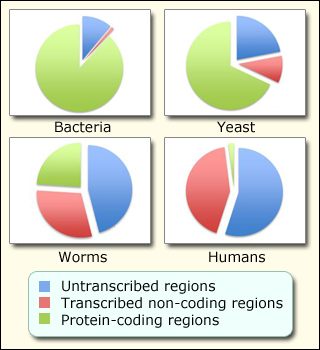
The non-coding regions of the genome have undergone an expansion throughout evolution, supporting their potential importance in organismal complexity. These transcribed non-coding regions give rise to various classes of small or long non-coding RNAs. Research during the last decade has been instrumental in elucidating the roles of these genes in normal physiology and disease. (Image by MIT OpenCourseWare, pie charts courtesy of Dr. Nadya Dimitrova and Dr. Thales Papagiannakopoulos.)
Instructor(s)
Dr. Nadya Dimitrova
Dr. Thales Papagiannakopoulos
MIT Course Number
7.345
As Taught In
Spring 2012
Level
Undergraduate
Course Description
Course Description
Every time we scientists think that we have dissected the precise biological nature of a process, an incidental finding, a brilliantly designed experiment, or an unexpected result can turn our world upside down. Until recently thought by many to be cellular "junk" because they do not encode proteins, non-coding RNAs are gaining a growing recognition for their roles in the regulation of a wide scope of processes, ranging from embryogenesis and development to cancer and degenerative disorders. The aim of this class is to introduce the diversity of the RNA world, inhabited by microRNAs, lincRNAs, piRNAs, and many others.
This course is one of many Advanced Undergraduate Seminars offered by the Biology Department at MIT. These seminars are tailored for students with an interest in using primary research literature to discuss and learn about current biological research in a highly interactive setting. Many instructors of the Advanced Undergraduate Seminars are postdoctoral scientists with a strong interest in teaching.


